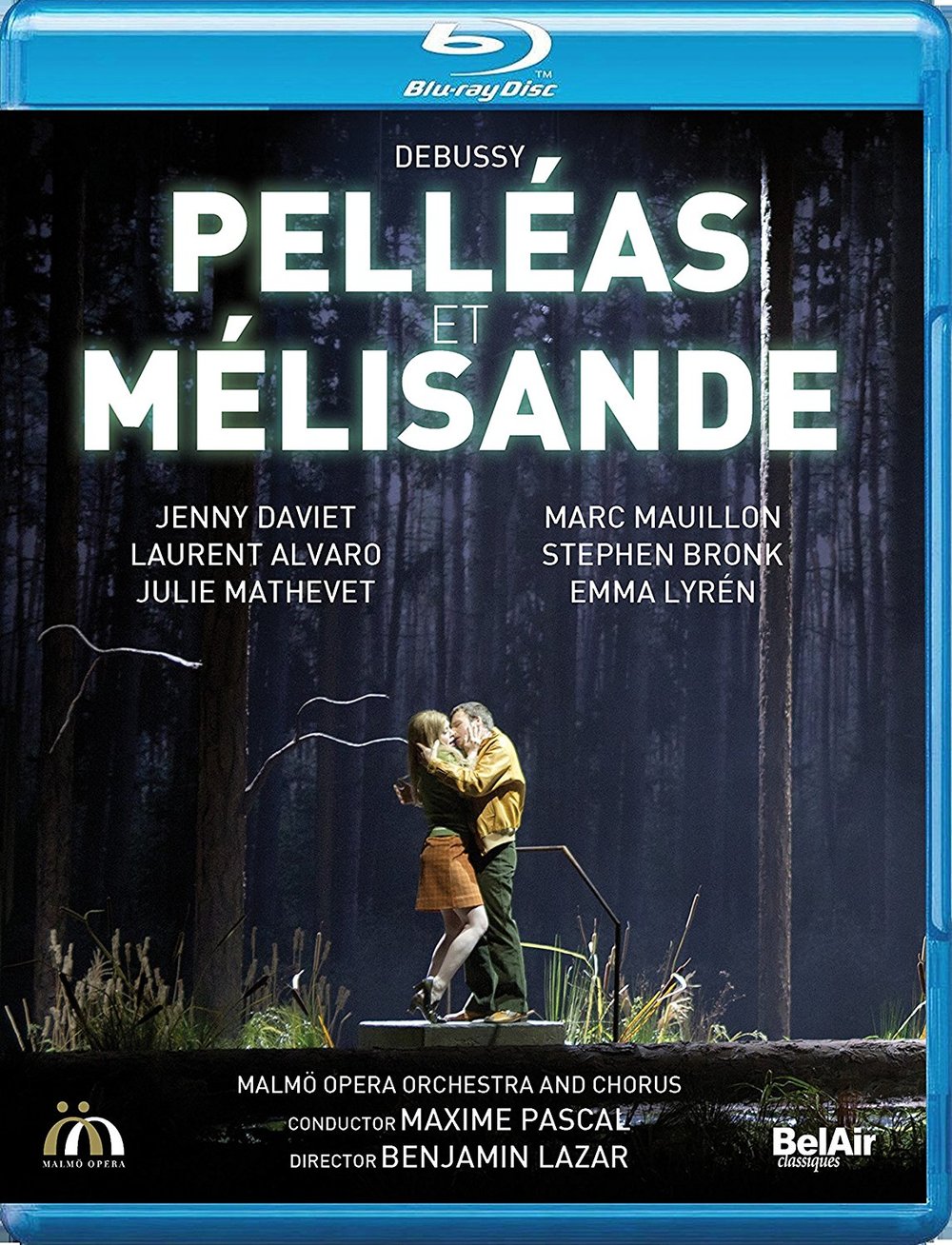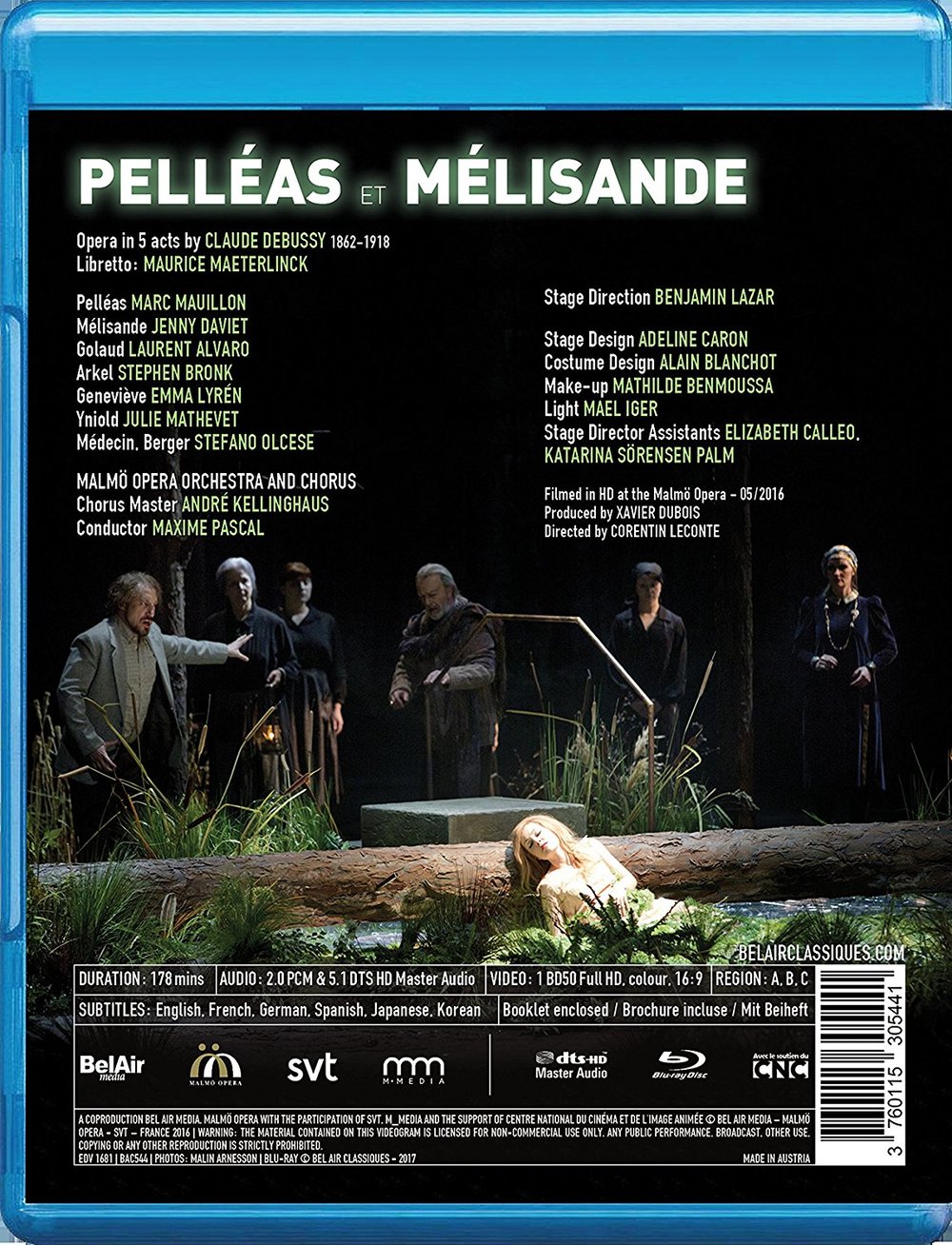

Debussy Pelléas et Mélisande opera to libretto by Maurice Maeterlinck. Directed 2016 by Benjamin Lazar (with assistance from Elizabeth Calleo and Katrina Sörensen Palm) at the Malmö Opera. Stars Marc Mauillon (Pelléas), Jenny Daviet (Mélisande), Laurent Alvaro (Golaud), Stephen Bronk (Arkel), Emma Lyrén (Geneviève), Julie Mathevet (Yniold), and Stefano Olcese (Doctor/Shepherd). Maxime Pascal conducts the Malmö Opera Orchestra and Chorus (Chorus Master André Kellinghaus). Stage design by Adeline Caron; costume design by Alain Blanchot; make-up by Mathilde Benmoussa; lighting by Mael Iger. Directed for TV by Corentin Leconte; produced by Xavier Dubois. Sung in French. Released 2017, disc has 5.1 dts-HD Master Audio sound. Grade: B
Go to our story on the Essener Philharmoniker version of Pelléas et Mélisande for background on the opera and a genealogy of the Arkel royal family. In this review I mostly focus on peculiar features of the Malmö Opera disc.
I observed earlier that Pelléas et Mélisande is an tricky opera to produce because the libretto suggests so many different physical sets. A rotating stage can help. But the solution adopted by the Malmö opera team was to use a single set that shows a forest and a castle simultaneously! It sounds a bit crazy, but in our opening screenshots below, you can see how they did this. The first shot is a castle scene in which the chandelier lights are turned on. There is a throne for King Arkel (Stephen Bronk), some suggestion of wooden structures in the background, and Geneviève (Emma Lyrén) is reading to the King from the letter Prince Golaud wrote to his beloved half-brother Pelléas. Spotlights attempt to focus your attention on the singers and to obscure as much as possible of the trees and forest foliage. If you know the opera pretty well, you have a fighting chance to figure out what’s going on. But a newcomer to this opera would probably be very puzzled by these chandeliers in the woods:
Next below is the scene on the lookout high on a crag rising in the fantastic castle garden. An observation tower is rolled forward from the shadows and mounted by Mélisande (Jenny Daviet) and Pelléas (Marc Mauillon). Only the weird chandelier is out-of-place; but since it is turned off, it isn’t there.
All the costumes in this production are modern dress. I get the impression that the Malmö Opera folks asked each teacher at a local high-school to donate his or her ugliest unwanted garment to be used in this show. That might explain why there is so much orange, off-yellow, and dull shades of green and gray worn by the protagonists:
On the left of the stage, some steps with a handrail represent the Fountain of the Blind. If you don’t know the opera and don’t speak good French, you might be hard pressed to realize that this is a water feature (looking really hard you can see a bit of water surface behind the shrubbery):
The next screenshot below is my favorite image from this disc. Jenny Daviet is an exceptionally young and pretty Mélisande. Her pleasant singing voice is more than adequate for the style invented by Debussy for this opera. As to acting ability, I think she was directed to appear throughout as aloof, otherworldly, and therefore mysterious. Here she supports herself on one hand and a knee, which puts her under considerable strain working those core muscles. If I saw this image out of context I might assume that the girl here was created by a computer and that we are in the infamous “uncanny valley” where an artificial image of a person is so close to perfect that it starts to appear threatening or even monstrous. The sickly yellow and grey-green colors of her dress reinforce the strangeness. Director Lazar and videographer Leconte have succeeded here in making Jenny look like a symbol rather than a real girl:
I think the libretto has both Pelléas et Mélisande hopelessly in love as soon as they meet for the first time on the observation tower. In the old days, observation towers were for military security, but in modern times they are mainly used for falling in love. Lazar sees it differently. In the next two images below we are at the Fountain of the Blind and this is when we realize that Pelléas and his sister-in-law have fallen in love. Oh, yes, that’s what they say: Love is blind.
As Mélisande accidentally drops her wedding ring in the well, both lovers look like symbols than people:
In the next shot below, considerable time has passed and we enter the famous tower scene. The costume designer was clever in coming up with a fur coat that suggests long hair. Mélisande is still wearing her symbol dress. :
If I had seen this live, I fear the difficulties with the castle-in-the-forest set would have left me in frustration. But Leconte manages, I think, to improve on the live show with his video file consisting of a nice mix of long-distance, mid-range, and close-ups:
Below Golaud (Laurent Alvaro), dressed like a high school physics teacher, is losing it. Now poor Jenny has changed into an atrocious orange and olive outfit she will wear until the death of Pelléas. The sloppy modern dress seems inconsistent with the three-hundred-year-old sword leaning against the plastic pine tree:
Finally, here are some more mid-range and close-up shots in which Leconte lets us ignore the clutter of the forest/castle set and focus on the singers:
A stab in the back:
Below is Jenny Daviet’s best-delivered line, offered up with striking insouciance. I think she could be really terrific in a better production as she has everything a girl would need to cause a lonely older guy to go nuts:
This was an odd and uneven show that was maybe fun to watch (if you were well versed in the libretto). What you see on this disc is not up to, I fear, BelAir’s normal standard for Blu-ray opera titles. But I’m happy to mention now a redeeming aspect of the disc that I saved to the end: the orchestra playing and the sound recording are exceptionally good. Debussy’s score isn’t treated as background music: it’s right there with you in startling clarity from start to finish, and this is achieved without crowding out or covering up the singers. I wish they had included more video of the orchestra in the interludes; instead, we see typical “filler action” on the stage such as shots of Golaud’s son Yniold playing in the forest with his strange collection of toys.
The subtitles in English are a hoot. My favorites include “Why do you have a look so surprised?”, “It’s an old well abandoned.”, and “I heard crackling leaves dead.”
As to a grade, I start with a C- for the confusing mise-en-scène, unremarkable directing, and the distracting, ugly costumes. But for the beauty of Jenny Daviet, the orchestra playing, good PQ, and fine SQ, I move the grade up to a B (or better if you are especially interested in the orchestral score).
Here’s a short YouTube clip —where did they find those horrible shoes?
OR













